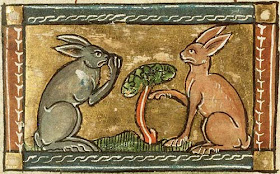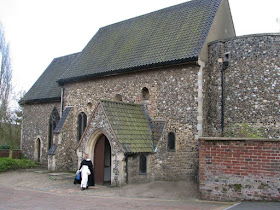A warm welcome to guest Regan Walker, who posts on the 'hop'-topic of Hares and Rabbits in Medieval England. G x
 |
| Medieval rabbits |
Though both hares and rabbits existed
in medieval England, the rabbit was a rare beast and much sought after for both
its meat and its fur. Unlike the hare, the rabbit was not native to Britain,
but was deliberately introduced from France or the western Mediterranean by the
13th century. While the hare is considered native to Britain, it is
possible the Romans may have introduced it. However, there are no records of
them in Britain before Norman times, the 11th century.
My new novel, Rogue Knight, is set in Yorkshire in 1069-70 when William the
Conqueror came north to claim Northumbria and engaged in the debacle we know
today as the “Harrying of the North” causing the deaths of as many as 100,000
people.
 |
| The Yorkshire Dales |
I like to think that some people,
chased from their homes by William’s army and deprived of the ability to grow
food, might have survived on the brown hare, native to Yorkshire. Certainly my
heroine and her family, hiding out from the Normans, dined on hare while living
in the woods.
The brown hare is generally larger than
a rabbit. They have long, black-tipped ears and a tall and leggy appearance.
They are timid and fast runners. They prefer grassland fields and some woodland
in their habitat. In the Peak District of England, you will find the smaller
mountain hare.
 |
| The Brown Hare by Whitfield Benson |
Unlike young rabbits, that are born
blind and furless, totally dependent upon their mother, young brown hares,
called leverets, are born fully formed and active, weaned in a month. Their
average life expectancy is three years. Rabbits raised in captivity might live
longer. In the Middle Ages, rabbit-warrens were almost the sole source of
supply for rabbits and that is one reason they were so valuable and closely
guarded.
Throughout the medieval era, beginning
after the Norman Conquest the right to hunt and kill any beast or game was a
privilege granted by the king. The Anglo-Saxon
Chronicle in a verse written shortly after his death states, “He made great
protection for the game and imposed laws for the same, that who so slew hart or
hind should be made blind.” (William the Conqueror seemed to love poking out
people’s eyes.) And, as for the hares, “…did he decree that they should go
free.” (Meaning they could not be hunted for the Chronicle indicates “Powerful men complained of it and poor man
lamented it, but so fierce was he that he cared not for the rancor of them
all…”)
 |
| Brown Hare by Matt Neale |
It appears that the royal forests of
the kind that existed in the 12th century were, thus, a Norman
creation. The Domesday Book, written in 1086 at the order of William I,
indicates that the royal forest was created though a combination of eviction
and the taking of woodland and uninhabited land. At the height of the royal
forest practice in the late 12th and early 13th centuries, fully one-third of
the land area of southern England was designated as royal forest.
Hunting in the royal forests was the
privilege of the king alone. Outside of those areas, the king would sell
hunting rights by means of a charter that allowed the killing of the “beasts of
warren”—pheasant, partridge, hare and rabbit. Hence the right to keep and kill
rabbits was the exclusive right of the owner of the “free-warren”. Grants of
warren—the right to hunt hares—can be found from the reign of at least William
II and perhaps William I.
 |
| Hare and Knight |
Henry I, as reported in the Gesta Stephani, “claimed for himself
sole hunting rights of wild beasts throughout England…” That doesn’t leave a
poor man many options to feed his family, but perhaps a hare in a remote area
found its way into a poor family’s stewpot.
A huge thank you to Regan for this fascinating and hare-raising post! As ever Regan lives and breathes history, and I'm grateful to her for sharing that love with us.
So let's 'hop' to it and find out about Regan's latest release...Rogue Knight.
"Mesmerizing medieval romance! A vivid portrayal of love
flourishing amidst the turbulence of the years after the Norman Conquest."
-- Kathryn Le Veque, USA Today Bestselling
Author
York, England 1069… three
years after the Norman Conquest
The North of England seethes with discontent under the heavy
hand of William the Conqueror, who unleashes his fury on the rebels who would dare
to defy him. Amid the ensuing devastation, love blooms in the heart of a
gallant Norman knight for a Yorkshire widow.
A LOVE NEITHER CAN
DENY, A PASSION NEITHER CAN RESIST
Angry at the cruelty she has witnessed at the Normans’ hands,
Emma of York is torn between her loyalty to her noble Danish father, a leader
of the rebels, and her growing passion for an honorable French knight.
Loyal to King William, Sir Geoffroi de Tournai has no idea
Emma hides a secret that could mean death for him and his fellow knights.
WAR DREW THEM
TOGETHER, WAR WOULD TEAR THEM APART
War erupts, tearing asunder the tentative love growing
between them, leaving each the enemy of the other. Will Sir Geoffroi, convinced
Emma has betrayed him, defy his king to save her?
Pinterest
storyboard for the Rogue Knight (Always worth checking out!)




















































